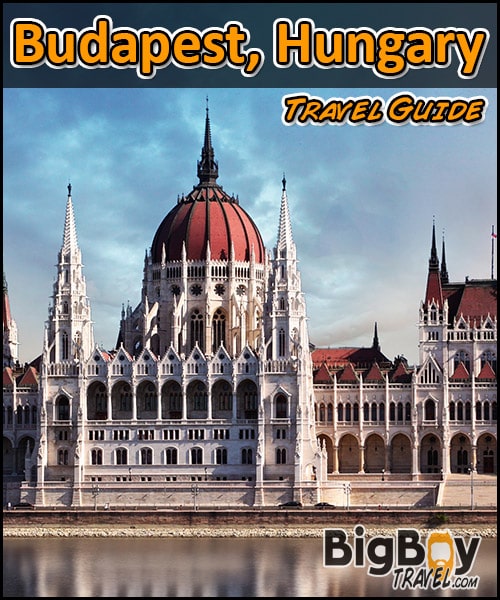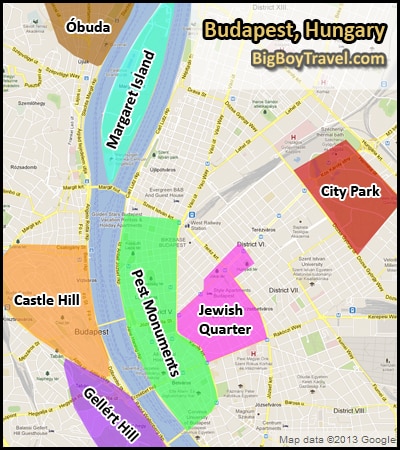Europe > Hungary > Budapest Travel Guide
Budapest Travel Guide:
Officially Founded In: As Aquincum in 41 AD; Hungary established in 896 AD; three towns merged to form Budapest in 1873.
Language: Hungarian (Magyar) is the official language, German is the official minority language, and English is the 3rd most spoken language & widely understood in tourist areas.
Currency: Forint (noted as HUF or FT), 1 US Dollar = 277 HUF
Suggested Length of Stay: 2 to 4 Full Days.
Overview of Budapest:
Szia (Hello) and welcome to Budapest, the capital of Hungary and a vibrant metropolis with very strong medieval routes. From it’s founding in 896 A.D. the area was originally three parts split by the Danube River; Pest to the west, Buda to the east, and Óbuda to the North. In the 1873, these three cities joined forces to create the Hungarian capital of Budapest, but the effects of war since then make it a miracle the city still exists at all.
Explore Budapest By Neighborhood:
Helpful Historical Timeline Of Budapest:
350,000 B.C. Oldest known people in the Carpathian Basin of modern Hungary when a Homo Erectus from then was found in 1965
800 B.C. Tribal groups form on the boundaries of Carpathian Basin
41 A.D. Founded as a Roman military camp called as Aquincum (Óbuda)
106 A.D. Becomes the capital of the Roman state called Pannonia
434 A.D. The Hunnic Empire, led by Atila the Hun establish their capital city in modern-day Hungary ruling huge parts of Eastern Europe and Western Asia.
453 A.D. The Hunnic Empire starts to fall with the death of Atila and most of the Carpathian Basin of modern Hungary remains unsettled territory.
896 A.D. Seven Magyar Tribes (pronounced mad-yar) led by High Prince Álmos become the first permanent settlers the Carpathian Basin of modern Hungary since the Huns pulled out. Today the Magyars are considered the first Hungarians.
1000 A.D. Saint Stephen I become the fist King of Hungary, Christianity reins
1242 A.D. Mongolians invade Budapest pillaging and destroying many buildings
1456 A.D. Hungarians beat Ottoman’s Battle of Belgrade to Protect Hungary
1458 A.D. After being Knighted for fighting in the Battle of Belgrade at age 13, Matthias Corvinus becomes King of Hungary at age 15. Although he was of nobility, he was the first King to not be part of the same lineage. The greatly expanded Hungary’s power and also became Duke of Austria and King of Bohemia during his rein. He was widely considered the People’s King as he took power from the nobles, evened out taxes, befriended the Ottomans, conquered Vienna and brought Hungary to its Golden Age in the late 1400’s. Matthias Corvinus who was from Transylvania famously arrested Vlad III the Impaler (Dracula) and had him imprisoned of 10 year in his boyhood home estate.
1541 A.D. Ottomans finally takeover Budapest after trying for 100 years and turn most churches in mosques, Islam reins
1686 A.D. The Hapsburg help kick out the Ottomans, Christianity reins again
1867 A.D. Reconciliation occurs which starts the Austria-Hungary Empire.
1873 A.D. The three cities of Buda, Pest, and Óbuda (Ancient Buda) unite to form Budapest
1896 A.D. Budapest hosts the World Expo and gets the area of City Park gets a huge facelift from the widening of Andrássy Avenue, to the building of many iconic structures in the park including Vajdahunyadvár Castle, Heroes’ Square, and many more.
1918 A.D. Fresh off a WWI loss, the Austria-Hungary Empire splits into separate countries
1930’s The Arrow Cross group comes to power and aligns themselves up with Hitler.
1944 A.D. Full German Nazi occupation of Budapest starts, the Jewish Ghetto is closed off, and tens of thousands of citizens are murdered by Arrow Cross and the Nazis as part of the Holocaust.
1945 A.D. Soviets defeat the Nazis in the Battle of Budapest. They quickly opened the Jewish Ghetto and were viewed as liberators. This helped turn Hungary into a Communist Nation fairly quickly.
1956 A.D. Hungarian Revolution starts as the people want to move further away from the USSR. 200,000 protesters come up with 16 demands to reform the Government which are shot down and the protest turns into revolution. The Soviets brought their tanks in to crush the uprising and in total 25,000 Hungarians are killed with 250,000 fleeing the country. The president at the time, Imre Nagy, agreed and wanted to stay Marxist but also wanted to open up new freedoms. He had opened up voting to far more people including woman then was secretly charge with treason by members loyal to the USSR and was hung. Saying his name soon became illegal as it was a symbol of freedom and the Soviet-backed leaders rule Hungary.
1989 A.D. Soviet Union begins to fall as the Cold War ends.
1991 A.D. Member countries withdraw from the Warsaw Pact ending their Soviet rule and the last of the Soviet soldiers leave Hungary. Hungary breaks Communism and turns into a true Democracy







